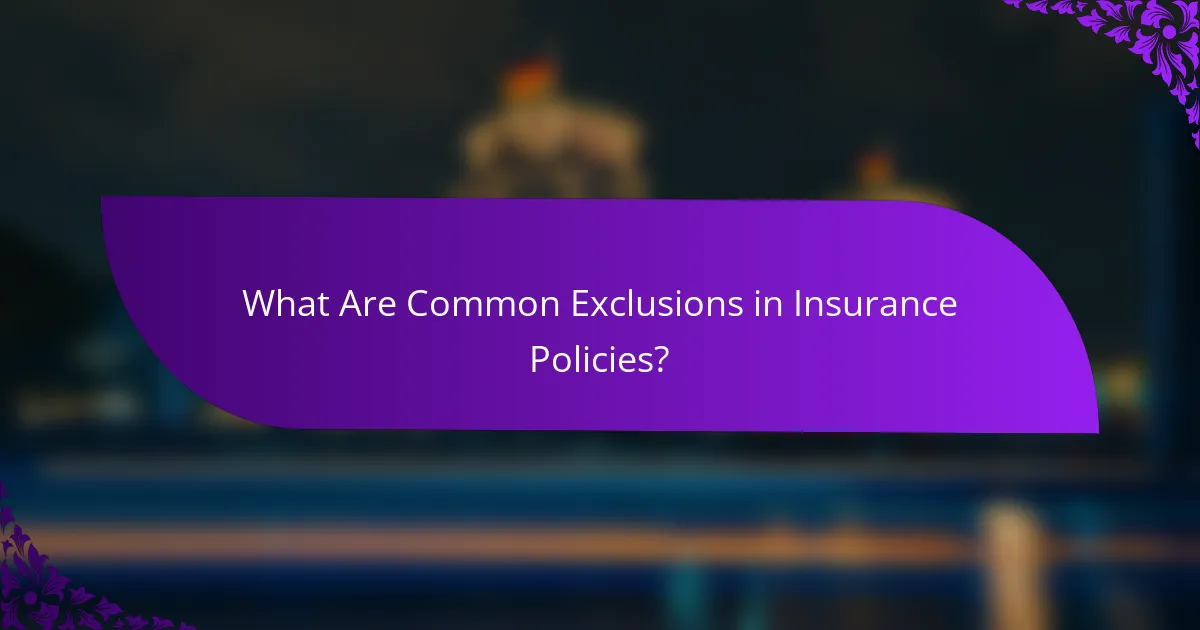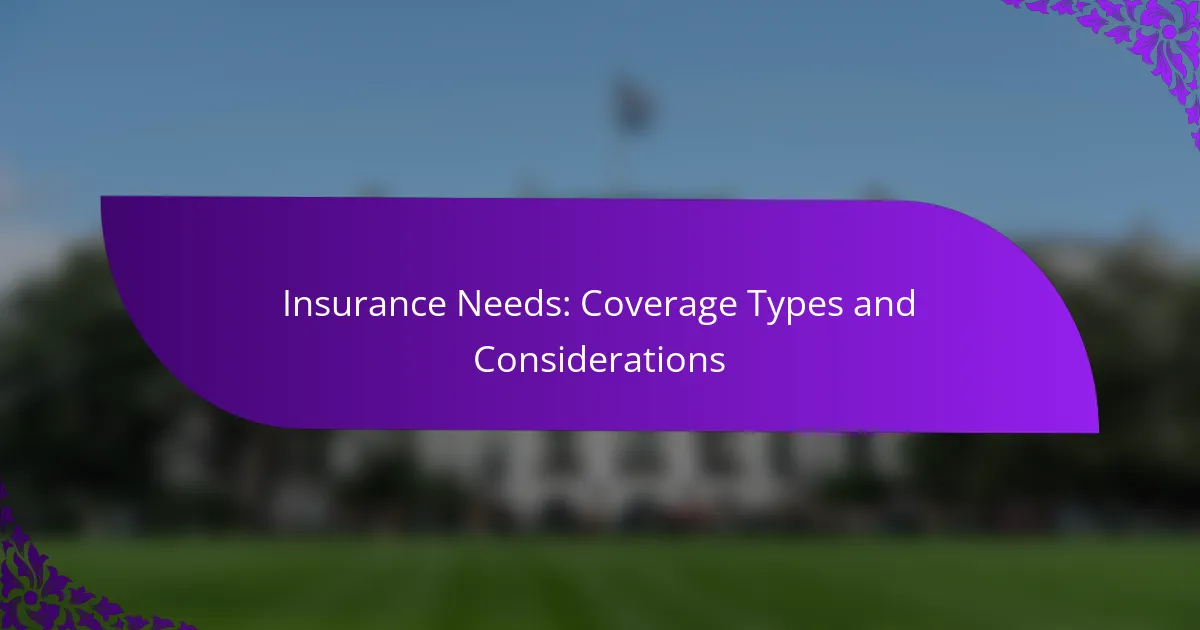Understanding your insurance needs is crucial for safeguarding your financial future. Essential coverage types, such as health, auto, homeowners, life, and disability insurance, each address specific risks that individuals and families may face. By evaluating your unique circumstances and comparing policy features, you can select the right coverage that fits both your needs and budget.

What Are the Essential Insurance Coverage Types?
Essential insurance coverage types include health, auto, homeowners, life, and disability insurance. Each type serves a specific purpose, protecting individuals and families from financial risks associated with health issues, accidents, property loss, death, and income loss due to disability.
Health Insurance
Health insurance provides coverage for medical expenses, including doctor visits, hospital stays, and prescription medications. It typically involves monthly premiums, deductibles, and co-pays, which can vary widely based on the plan and provider.
When choosing health insurance, consider factors such as coverage limits, network of providers, and out-of-pocket costs. Many employers offer plans, but individuals can also explore options through government exchanges or private insurers.
Auto Insurance
Auto insurance protects against financial loss in the event of vehicle damage, theft, or accidents. Most states require a minimum level of coverage, which usually includes liability, collision, and comprehensive insurance.
When selecting auto insurance, evaluate your driving habits, the value of your vehicle, and your budget. Comparing quotes from multiple insurers can help you find the best coverage at a competitive price.
Homeowners Insurance
Homeowners insurance covers damage to your home and personal property, as well as liability for injuries that occur on your property. This insurance is often required by mortgage lenders and can vary based on the home’s value and location.
Consider factors such as coverage limits, deductibles, and additional endorsements for natural disasters or personal property. Regularly reviewing your policy ensures that you have adequate coverage as your needs change.
Life Insurance
Life insurance provides financial support to beneficiaries in the event of the policyholder’s death. There are two main types: term life, which covers a specific period, and whole life, which offers lifelong coverage and a cash value component.
When choosing life insurance, assess your financial obligations, dependents, and long-term goals. A common guideline is to have coverage equal to 10-15 times your annual income to ensure your loved ones are financially secure.
Disability Insurance
Disability insurance offers income replacement if you become unable to work due to illness or injury. It can be short-term or long-term, with benefits typically covering a percentage of your salary.
Evaluate your current income, savings, and existing coverage when considering disability insurance. Many employers provide some level of coverage, but purchasing an individual policy can fill gaps and provide additional security.

How to Choose the Right Insurance Coverage?
Choosing the right insurance coverage involves evaluating your specific needs, comparing different policy features, and understanding the associated premium costs. This process ensures that you select a policy that adequately protects you while fitting your budget.
Assessing Personal Needs
Start by identifying your unique circumstances, such as your lifestyle, assets, and potential risks. Consider factors like your age, health status, and whether you have dependents, as these will influence the type and amount of coverage you require.
For example, a young professional may prioritize renters insurance, while a family might need comprehensive home and auto coverage. Make a list of your most valuable assets and any liabilities to determine what needs protection.
Comparing Policy Features
Once you know your needs, compare the features of various insurance policies. Look for coverage limits, exclusions, and additional benefits that may be included, such as roadside assistance or identity theft protection.
Utilize online comparison tools or consult with an insurance agent to evaluate policies side by side. Pay attention to the terms of coverage, as some policies may offer more extensive protection than others for similar premiums.
Understanding Premium Costs
Premium costs can vary significantly based on factors like coverage type, deductible amounts, and your personal risk profile. Generally, higher coverage limits and lower deductibles lead to higher premiums.
To manage costs, consider increasing your deductible if you can afford to pay more out-of-pocket in the event of a claim. Additionally, look for discounts that may apply, such as bundling multiple policies or maintaining a good claims history.

What Factors Influence Insurance Premiums?
Insurance premiums are influenced by various factors that assess the risk associated with insuring an individual or property. Key elements include age, health status, location, and claims history, all of which can significantly impact the cost of coverage.
Age and Health Status
Age and health status are critical determinants of insurance premiums. Generally, younger individuals may face higher rates for certain types of insurance, such as life or health coverage, due to a perceived higher risk of accidents or health issues as they age. Conversely, older adults may see increased premiums due to age-related health risks.
Health status also plays a vital role. Those with pre-existing conditions or chronic illnesses often pay more for health insurance. Insurers may require medical examinations or health questionnaires to assess risk accurately, which can lead to varied premium rates.
Location and Risk Assessment
Your location significantly affects your insurance premiums due to varying levels of risk associated with different areas. For instance, living in regions prone to natural disasters, such as floods or hurricanes, can lead to higher homeowners’ insurance costs. Urban areas may have increased rates due to higher crime rates compared to rural locations.
Insurance companies often conduct risk assessments based on local data, including crime statistics and environmental factors. Understanding these risks can help individuals make informed decisions about their coverage needs and potential costs.
Claims History
Your claims history is a crucial factor in determining your insurance premiums. A record of frequent claims can signal higher risk to insurers, leading to increased rates. For example, if you have filed multiple auto insurance claims, you may face higher premiums when renewing your policy.
To mitigate potential premium increases, it’s advisable to maintain a clean claims record and consider raising deductibles for minor incidents. Additionally, some insurers offer discounts for policyholders who have not filed claims for a certain period, rewarding responsible behavior.

What Are Common Exclusions in Insurance Policies?
Common exclusions in insurance policies refer to specific situations or conditions that are not covered by the policy. Understanding these exclusions is crucial for policyholders to avoid unexpected financial burdens when filing a claim.
Pre-existing Conditions
Pre-existing conditions are health issues or injuries that existed before the start of an insurance policy. Many health insurance plans exclude coverage for these conditions for a certain period, often ranging from six months to a year. It’s essential to review your policy to understand how pre-existing conditions may affect your coverage.
For example, if you have diabetes before purchasing health insurance, treatment related to that condition might not be covered initially. Always disclose any pre-existing conditions to your insurer to avoid complications later.
Natural Disasters
Natural disasters, such as floods, earthquakes, and hurricanes, are frequently excluded from standard property insurance policies. Homeowners may need to purchase separate coverage or riders to protect against these specific risks. Check your policy to see if natural disaster coverage is included or if additional premiums apply.
For instance, in areas prone to flooding, a standard homeowner’s policy may not cover flood damage, necessitating a separate flood insurance policy. Understanding these exclusions can help you make informed decisions about your insurance needs.
Negligence
Negligence refers to the failure to take reasonable care, which can lead to accidents or damages. Many insurance policies exclude coverage for damages resulting from negligent actions, particularly if they involve willful misconduct or illegal activities. It’s vital to understand the implications of negligence in your policy to avoid denial of claims.
For example, if a homeowner fails to maintain their property, leading to an injury on their premises, their liability insurance may not cover the claim due to negligence. Always maintain your property and follow safety regulations to minimize risks and potential exclusions.

How Does Insurance Coverage Vary by Region?
Insurance coverage can differ significantly by region due to local laws, economic conditions, and cultural factors. Understanding these variations is crucial for selecting appropriate coverage that meets specific needs.
Health Insurance Variations
Health insurance coverage often varies based on regional regulations and available plans. For instance, countries with universal healthcare systems may offer different services compared to those relying on private insurance markets. In the U.S., coverage can differ widely between states due to varying Medicaid programs and state-specific regulations.
When evaluating health insurance, consider the types of plans available, such as HMOs, PPOs, or EPOs, and their respective costs. It’s essential to review the network of providers and the coverage limits for different treatments, as these can impact out-of-pocket expenses significantly.
Auto Insurance Differences
Auto insurance requirements and coverage options can vary greatly by region, influenced by local laws and accident rates. For example, some states in the U.S. require minimum liability coverage, while others may mandate personal injury protection (PIP) or uninsured motorist coverage.
When selecting auto insurance, assess the minimum coverage requirements in your area and consider additional options like comprehensive and collision coverage. It’s advisable to compare quotes from multiple insurers to find the best rates and coverage options tailored to your driving habits and regional risks.
Homeowners Insurance Considerations
Homeowners insurance coverage can differ based on geographical risks such as natural disasters, crime rates, and local regulations. Areas prone to flooding or earthquakes may require additional coverage or specific endorsements that are not standard in other regions.
When choosing homeowners insurance, evaluate the coverage limits for dwelling, personal property, and liability. It’s beneficial to review local risks and ensure that your policy includes adequate protection against common hazards in your area, such as fire or theft.
Life Insurance Options
Life insurance options can vary by region, influenced by local market conditions and regulations. Different types of policies, such as term life or whole life, may be more prevalent in certain areas based on consumer preferences and financial literacy.
When considering life insurance, assess your financial goals and the needs of your dependents. It’s wise to compare policies from various insurers, focusing on premiums, coverage amounts, and any riders that may enhance your policy, such as critical illness coverage.
